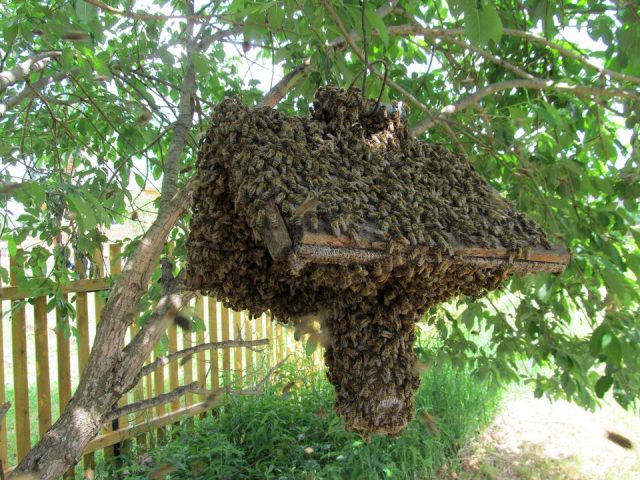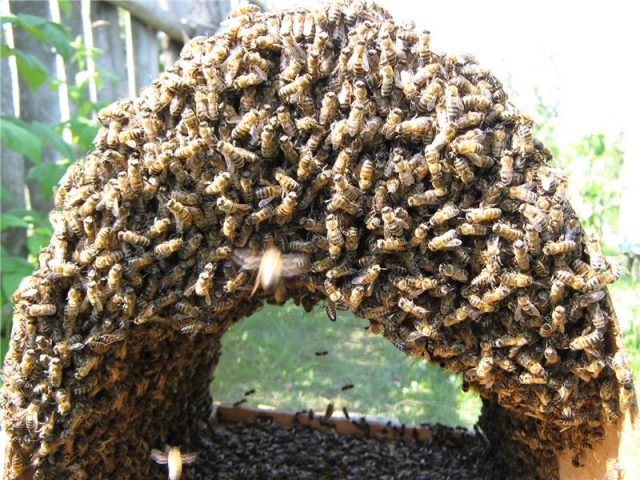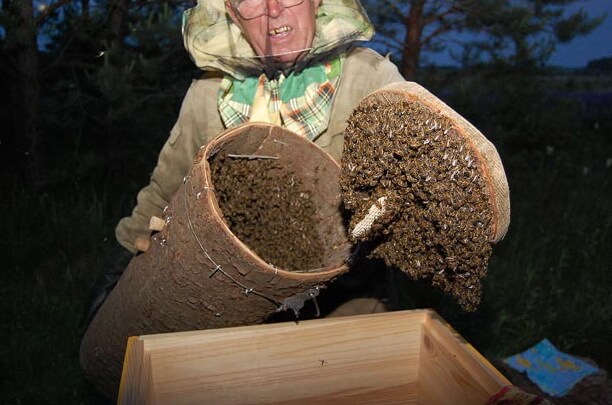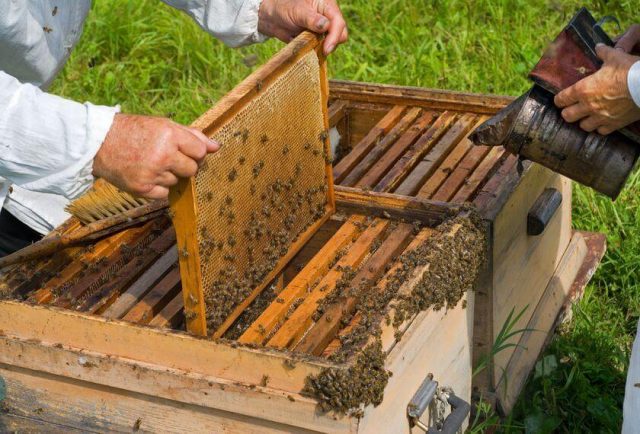Content
Swarming of bees is a natural process of migration from the hive, which threatens the beekeeper with significant losses. A swarm of bees leaves the nest for a number of reasons. Most often, various diseases or overpopulation act as a provoking factor. Knowing preventive measures, you can avoid the separation of the bee colony.
What is "swarm"
The swarm is part of the bee family that has decided to leave the hives. Each swarm has a leader who is a womb. Most of the swarm is represented by workers. The rest of the bees are called drones. Their main function is fertilization. A bee swarm is capable of moving more than 20 km from the mother's family.
The flight of bee swarms does not depend on the cardinal points. The direction is chosen, depending on the weather conditions. The main task of bees is to find a new home. The environment is assessed by the scout bees, who fly out of the hive before the rest of the individuals. The height of the grafting site directly depends on the state of the family. Weakened bees can stay close to the ground or near the burrow of any animal. Stronger swarms rush to the branches of the trees.
How the bees swarm
Swarming of bees is an insect migration process caused by natural or artificial causes. This process is aimed at maintaining the population of the species. In the process of swarming, the most active individuals, together with the queen, leave the hive and go in search of a new home. Most often, insects are chosen by bird cherry, plum, viburnum, conifers or maple.
Swarming aimed at reproductive growth is carried out in late spring - early summer. During this period, the number of drones in the bee's nest increases and the queen's eggs are laid. Due to the active work in the hive, there is little space. If the beekeeper does not take care of expanding the nest in time, the bees will start swarming. Weakened bee colonies swarm in the fall, as they manage to gain strength over the summer.
Despite the fact that bees leave their home suddenly, this process can be predicted about 7-10 days before the start. During this period, characteristic signs of swarming of a bee colony appear. Experienced beekeepers predict migration based on the queen cells formed on the combs. In some cases, there is a need for artificial swarming of bees. For example, when the uterus is sick or the nest is ruined during the wintering period.
More often than not, only one swarm emerges from the hive. But there are cases when several are released at once. But in such situations, the uterus in subsequent swarms will be infertile. The beekeeper should catch this swarm and combine it with the existing one. This will help increase the chances of a successful bee colony in the future. The newly formed, separated from the old, a swarm of bees in beekeeping is called a juvenile.
Causes of swarming bees
Swarming of bees occurs under the influence of internal or external provoking factors. The most common cause is overpopulation of the hive. This problem can be easily prevented if detected in time. The following reasons can also provoke swarming:
- violation of air exchange in the hive;
- aging of the uterus;
- excessive amount of bee brood;
- overheating of the nest as a result of improper selection of its location;
- lack of space in the nest.
Working individuals of the bee family are interested in favorable conditions for vigorous activity. Disturbed air exchange and high temperatures can provoke the exit of bees outside the inhabited territory. To prevent stuffiness in the hive, it is necessary to widely space the entrances and periodically close the bee house from direct exposure to sunlight. The bee swarm, the photo of which is located above, will not leave the hive if all favorable conditions are created in it.
A swarm of bees is in direct proportion to the state of the uterus. If the egg-laying process stops due to the disease of the queen or her aging, the bees have a need for a new queen. By this time, the beekeeper needs to take care of raising a new leader. If this does not happen, then the process of swarming begins.
The unfortunate state of affairs in the hive is evidenced by the large number of covers. In this case, the bees cannot rise from the ground. They become too heavy due to tick infestation. As a source of infection, ticks weaken the defenses of the family. Ultimately, some of the bees leave the hive in search of a new home. If action is taken in time, migration can be avoided. But in this case, you will need to make efforts to restore the immunity of the bees.
Why bees swarm during honey collection
The honey collection period is accompanied by a daily increase in the weight of the hive by 3 kg. On average, this takes about 10 days. The family is engaged in providing itself with reserves for wintering. But sometimes problems can arise, as a result of which part of the family leaves the house. The main reason for the beginning of swarming during honey collection is the growth of the bee colony. The workers do not have enough space, so they are left idle. The uterus, in turn, cannot lay eggs. In this case, the bees left without work begin to build queen cells. After they are sealed, the large swarm leaves the house with the queen.
How many bees in 1 kg of swarm
The swarm of bees, located in the photo below, weighing 1 kg, contains more than 6,000 workers. The average weight of a bee is about 0.15 g.
Where do the swarms fly
It is almost impossible to predict which direction the swarm will fly. Most often they find a new dwelling 8 km from the old one. During its journey, the swarm takes a break, while scout bees fly around in search of the most suitable dwelling. Often, beekeepers, noticing signs of impending swarming, set up traps. It is them that the swarm chooses as a new hive. To increase the chances, it is necessary to form several traps at once.
Which uterus remains in the hive after swarming
When it comes to swarming in the spring, the old queen flies out of the hive. By this time, a young individual becomes viable. If she is sick or the beekeeper has purposefully cut her wings, the swarming is carried out under the leadership of a young queen. Accordingly, the old queen remains in the hive.
What month do bees swarm
If the bee colony is strong enough, then swarming occurs in May or early June. Weakened bees begin to lay queen cells later than necessary. Therefore, they swarm in the fall. The main antecedent is stopping the uterus from laying eggs. Bees become less active, they fly out of the hive less often to collect nectar. The construction of honeycombs is also stopped. Worker bees spend most of their time on the landing board.
When the bees release their last swarms
The swarming process takes place in stages. First, the pervak swarm leaves the hive. This takes place in the first half of the day, from 10 am to 2 pm.The swarm is grafted into nearby trees while the scout bees search for a new home. The second swarm leaves the hive in 4-5 days.
When the bees stop swarming
Normally, the swarming process ends with the arrival of cold weather. The maximum possible swarming period is from September to October. The annual cycle of a colony largely depends on the climatic conditions of the area in which they are located.
Working with swarms of bees
The actions of the beekeeper during the swarming of bees depend on how strong the family is and in what period the migration takes place. If the swarm has left its hive a few days before the start of honey collection, it means that the bees have a large supply of working energy. You should prepare for the swarming process long before it starts. It is necessary to prepare new hives and frames with dry land.
At first, the swarm is grafted near its former location. Knowing where the stop has occurred, the beekeeper can remove the swarm. This will require a ladder, a swarm and an impromptu landing net:
- Removal is carried out after the swarm has completely calmed down.
- The swarm is placed under the hive and the bees are shaken off with the help of jolts.
- After that, the swarm with a part of the bees is hung next to the grafting site.
- New individuals will fly into it.
The process of adaptation of bees to a new place is carried out gradually.
How to make an artificial swarm of bees
Sometimes there are interruptions in the work of the bee family. Most often, the reasons for the deviations include the absence of a uterus or insufficient strength of the family. In these cases, beekeepers provoke swarming, thereby taking control of the insect population. The most common methods of artificial swarming include:
- dividing the bee colony into two parts;
- plaque on the uterus;
- the formation of layering.
The advantages of artificial swarming include:
- increasing the reproductive capacity of bee colonies;
- the ability to plan the swarming process;
- no need to constantly be in the apiary for the beekeeper;
- control over the productivity of each individual family.
How to determine where the swarm is and where the thief bees are
Experienced beekeepers should be able to distinguish between swarms and thief bees. The main criterion is the behavior of the individuals that have appeared in the hive. If worker bees calmly fly in and out of the hive, then thieves fearfully react to every rustle. They look for a loophole to get inside the hive. If the bee goes unnoticed, it takes honey out of the hive and returns for it again. Other individuals arrive with her. The sentry bees immediately try to paralyze the caught thief by driving a sting into it.
Stopping nectar theft is not easy. The best way is to change the location of the hive location. But the easiest way is to prevent theft. To avoid the attack of thieves on the bee colony, you should be very careful. It is undesirable to leave the hive entrances open for a long time. It is also important to monitor the health of the uterus. Weakened families are most often attacked.
How to add a swarm to a weak family
A swarm who has left his home is called a wandering. After catching it, you need to determine where it is best to place it. One option is to plant the swarm in a weak family. To do this, you should wait for the manifestation of signs of queenlessness in the hive. Only after that, the swarm is poured onto the honeycomb or in front of the entrance. This avoids conflict between the bees. Before migrating insects, it is advisable to sprinkle with sugar syrup.
The first novice bees exude a characteristic scent. He will attract the rest of the family. The complete resettlement process generally takes no more than 30 minutes. When all the bees have entered the hive, you can start aligning the nest in width. After about a week, you can increase the productivity of the family by adding several brood frames. If the uterus in the swarm is too old, it is replaced with a younger and more active one.
How can a late swarm be saved
With the right approach, the beekeeper can keep a late swarm. Provided the necessary conditions are provided, the bees will successfully overwinter and will be ready for further work in the spring. The best option would be to unite the swarm with another family. You can also place insects in a winter house equipped with a thermostat. It is equally important to ensure good air exchange in the hive and to feed the family.
Can bees swarm in August
Swarming of bees in August is not uncommon. It is provoked by the mistakes of beekeepers, as a result of which diseases develop or overpopulation occurs. Statistics show that bees swarm more often in autumn than at the end of summer. In this case, you will notice increased activity in the hive. The uterus begins to fly and stops laying eggs. A common cause of swarming in August is the weakened state of the family.
What to do with August swarms
Normally, in August, the harvest is carried out after the end of the honey harvest. During this period, special attention must be paid to the swarm. Bees swarm in July and August as a result of any disturbance to the internal work of the hive. Therefore, it is important to raise as many young queens as possible so that the bee colony is productive by the spring.
Initially, bees are fed. After that, preventive treatment of the dwelling from ticks is carried out. It is also important to determine the amount of food reserves and assess the strength of the bee colony. Damaged and half-empty frames are removed from the hive. This avoids mold growth and rodent attacks.
The state of the bee colony is judged by the brood in the nest. It is important to keep as many viable individuals as possible for the winter. The intensity of their work in the spring depends on this. In the middle of the bee dwelling, combs with brood must be placed. Honeycombs are placed along the edges, and honeycombs a little further. The hive is carefully insulated, after which a protective agent against rodents is placed on the entrance. The wintering area is thoroughly cleaned and gets rid of high humidity. It is equally important to start decontaminating the future wintering place.
Feeding for bees is prepared from sugar syrup mixed in equal proportions with water. In rare cases, milk is substituted for water. To increase the defenses of the bee colony, the hive is sprayed with a decoction of wormwood, conifers or yarrow.
With the onset of cold weather, it is necessary to regularly monitor the condition of bees. During this period, the risk of attack by thief bees increases. It is advisable to check the hive late in the evening, after 21:00 h. In case of suspicion of the presence of strangers, it is necessary to block access to the entrances. It is also recommended to observe the following rules:
- you can not carry out top dressing earlier than the due date;
- you need to make sure that there are no sweet traces next to the hive;
- do not dry combs in the reach of wild insects;
- it is necessary to regularly observe the hive.
Conclusion
A swarm of bees leaves their home only when there are unfavorable conditions for further reproduction. The main task of the beekeeper is to provide quality care and protection from insects and bad weather conditions. Correct and timely action will help prevent the negative consequences of swarming.












